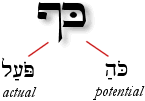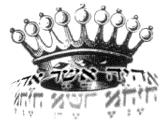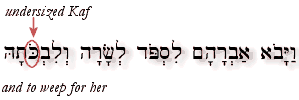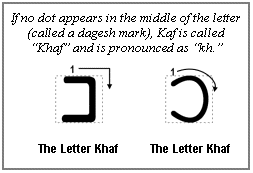|
|
 |
|
|
 |
 |
 |
 |
 |
|
 |
 |
 |
 |
 |
|
Advanced Information
|
|
|
|
 |
|
|
|
The letter Kaf is the 11th letter of the Aleph-Bet, having the numeric value of 20. The pictograph for Kaf looks like a palm of a hand, whereas the classical Hebrew script is constructed of a bent line that appears somewhat like a crown on the head of a prostrating king. Kaf is the first of the "double letters" in Hebrew, having both a "medial" form and an ending form (sofit).
- The Mystery of Kaf
In Jewish Mysticism, the two letters of the word "kaf" are the initial letters of the two Hebrew words: koach ("potential") and poel ("actual"), suggesting that Kaf enables the latent power of the spiritual (the potential) to be made actual in the physical:

The literal meaning of Kaf is "palm" which is considered the location where potential of the Yod (hand) is actualized (interestingly, the gematria for the word Yod is the same for the letter Kaf). For this reason we bless children with palms facing them and we envision God as having His palms over us, for this image suggests the calling forth of the latent power of the spirit within for manifestation in the physical world.
Also for this reason Chassidut considers reciting the Modeh Ani blessing with both palms together in the morning an act of soliciting the power of God to be made manifest in our daily lives.

Note: The Chamsa Hand (from chamesh, five, and therefore not directly related to Kaf) is a Jewish amulet symbolizing the Creator's protective hand that was thought to protect from the "evil eye" (einhoreh). The Chamsa is generally regarded as a superstitious article not associated with Jewish mysticism that is sometimes called the "hand of Miriam."
- The Meaning of Kaf
The word Kaf means "palm" of a hand and also what might be contained within the palm of the hand. The word "spoon" in Hebrew is the word Kaf, which is a natural extension of the palm as a container. The gematria for the letter Kaf is 20, the same value for the word Yod (hand), and twice the value of the letter Yod. Kaf comes from a root word (shoresh) kafah meaning to bend or bow down, suggesting the concave shape of the body or the shape of a crown on a king's head.
- Kaf and Kavvanah
Kaf begins the word  (kavvanah) which means spiritual focus and concentration (the root for this word means "to aim"). Kavvanah is a key concept in Jewish spirituality that suggests that you should rid your mind of all that is distracting and aim to envision yourself as standing directly before the divine Presence. (kavvanah) which means spiritual focus and concentration (the root for this word means "to aim"). Kavvanah is a key concept in Jewish spirituality that suggests that you should rid your mind of all that is distracting and aim to envision yourself as standing directly before the divine Presence.

- Kaf and Crowns

The word  (keter) means "a crown" (from katar, to crown). In the Jewish tradition, there are four crowns that are given to the Jewish people: (keter) means "a crown" (from katar, to crown). In the Jewish tradition, there are four crowns that are given to the Jewish people:
 - Keter Torah, the Crown of Torah (and also the crown used to adorn the Torah scroll in the synagogue) - Keter Torah, the Crown of Torah (and also the crown used to adorn the Torah scroll in the synagogue) - Keter Kehuna, the Crown of the Priesthood. - Keter Kehuna, the Crown of the Priesthood. - Keter Malkhut, the Crown of the Kingdom. - Keter Malkhut, the Crown of the Kingdom. - Keter shem tov, the crown of a good name. According to the sages, a good name is the best crown of all (Avot 4:17), since it is foundational to all the other crowns. And as Kohelet says, tov shem mishemen tov, "A good name is better than oil." - Keter shem tov, the crown of a good name. According to the sages, a good name is the best crown of all (Avot 4:17), since it is foundational to all the other crowns. And as Kohelet says, tov shem mishemen tov, "A good name is better than oil."
According to the sages, the Crown of Torah was given at Sinai when all Israel said, na'aseh v'nishma, "we will do and we will obey" in response to the giving of the Ten Commandments (Exodus 24:7). After the Golden Calf incident, however, the crowns of the priesthood and kingdom were said to have been taken away from the Israelites (though, of course, the Levites were later commissioned as priests and the Davidic line selected as kings). What remains for the regular Jew, then, is to wear the crown of Torah and the crown of a good name.
Now the gematria for  is 620, which the sages say is the number of the commandments of the Torah (613) plus the seven days of creation. By this they infer that the very world itself was created so that the Torah would be accepted and thereby ethical purpose given to the world (Minchah Beluah). is 620, which the sages say is the number of the commandments of the Torah (613) plus the seven days of creation. By this they infer that the very world itself was created so that the Torah would be accepted and thereby ethical purpose given to the world (Minchah Beluah).
In the New Testament at least five other crowns are identified:
 - Keter HaChayim, the crown of life (James 1:12), awarded for enduring the trials and tribulations of the olam hazeh. - Keter HaChayim, the crown of life (James 1:12), awarded for enduring the trials and tribulations of the olam hazeh. - Keter HaTzedakah - the crown of righteousness (2 Tim. 4:8), given to those who anticipate the coming of our Lord by living righteous lives before Him. - Keter HaTzedakah - the crown of righteousness (2 Tim. 4:8), given to those who anticipate the coming of our Lord by living righteous lives before Him. - Keter Olam - An incorruptible crown (1 Cor. 9:25), a picture of eternal life (chayei olam). - Keter Olam - An incorruptible crown (1 Cor. 9:25), a picture of eternal life (chayei olam). - Keter HaTiferet - the crown of glory (1 Peter 5:4), given to those who faithfully shepherd God's people. - Keter HaTiferet - the crown of glory (1 Peter 5:4), given to those who faithfully shepherd God's people. - Keter HaKotzim - Crown of thorns (Matt 27:29, Mark 15:17, John 19:5). This is the crown that only Yeshua is worthy to wear as our great High Priest who offered Himself up for our sins. - Keter HaKotzim - Crown of thorns (Matt 27:29, Mark 15:17, John 19:5). This is the crown that only Yeshua is worthy to wear as our great High Priest who offered Himself up for our sins.
The Lord Jesus is the One who possesses all the crowns of Israel and the Church. As Melekh HaYehudim He wears the Crown of the Kingdom; as Kohen HaGadol He wears the Crown of the Priesthood, as Devar Elohim He wears the Crown of Torah; as Ben Elyon He wears the Crown of the Good Name; as Sar HaChayim He wears the Crown of Life; as the Tzaddik after the order of Melkhi-Tzedek, He wears the Crown of Righteousness, as HaRo'eh HaTov, He wears the Incorruptible Crown, as Adon HaKavod He wears the Crown of Glory, and so on. Indeed, crown Him with many crowns!

- Kaf and Resembling King Messiah
Grammatically, when prefixed to a word Kaf means "like" or "as." For example, we prefix Kaf to melekh (king) to obtain k'melekh, like a king. Now the letter Kaf resembles the letter Bet, which we understand to be a picture of the Messiah Jesus. When we "prefix" ourselves to the Lord Jesus, we will be conformed to His image and resemble Him, just as Kaf resembles the Bet. And since Kaf pictures the palms of the hands, we will moreover resemble Jesus in our work and our sacrifice for others.
Furthermore, when following a word Kaf indicates "possession." For example, we append Kaf to melekh to obtain melekha, your king. Now since Kaf depicts a crown of a prostrated person, we can see that when we follow Jesus by "bending" (kafaf) our wills in submission to Him, we will be given the reward of the crown of righteousness (keter haTzedakah), since our works will follow His.
- "Palms" and Scripture
In Isaiah 49:16, the LORD poignantly declares that He has engraved Jerusalem upon the palms of His hands, thus illustrating His abiding concern for Zion:

Moreover, we are told to lift up our heart with our hands to God in Heaven:

The psalmist cries to stretch out his hands to God's mitzvot which he loves and to meditate upon God's chukim (statutes):

- Textual Oddity
There is an undersized Kaf found in Genesis 23:3

The sages say that this shows we should show restraint in our grieving and mourning since the righteous man understands that the soul is immortal and therefore the loss of relationship with the other is not permanent.
|
|
|
Hebrew for Christians
Copyright © John J. Parsons
All rights reserved.
|
|
|
|
 |
|
|
|
|
|
|






















